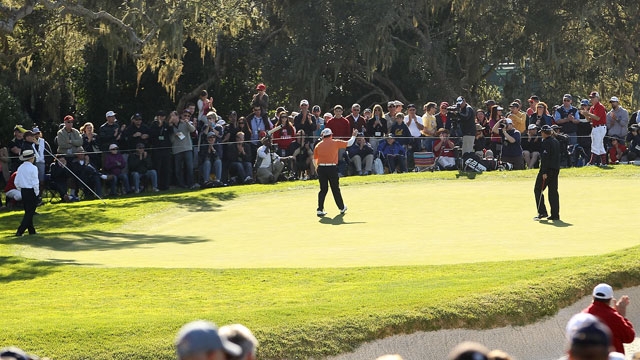NEWS
A Lesson Learned: Playing Pebble Beach effectively
By Danny Elkins, PGA
Published on

What an awesome event golf on the PGA Tour was this past week. The drama and action were tremendous and seeing Bill Murray show some flashes of golf brilliance in addition to the levity he brings was quite a treat. Congratulations to him in winning the "Am" portion of the AT&T Pebble Beach Pro-Am and adding a serious honor to his already iconic contribution to golf as Carl Spackler in Caddyshack.
And Murray's playing partner wasn't too bad either. D.A. Points won for the first time in his career, punctuated with a 100 yard hole out for eagle on the incredibly difficult par-5 14th hole and then a long bending birdie putt on the 15th. His performance was both solid and spectacular, a deserving champion for sure.
But to me, and to many, the real star of the week was the same as it is every year - Pebble Beach Golf Links itself. From the moment it opened in 1919, Pebble Beach has been a destination and goal for practically every golfer in America. I can tell you that it may be the only course I have ever played, and I've played my share, that actually exceeded expectations. Yes, it's that special.
But if you are planning to play at Pebble Beach, you of course want to play well. And like the successful Tour players this week, there is one basic thought to remember at Pebble and you'll do so much better, I promise. This week's Lesson Learned is, know where to miss and know your limitations.
What many people do not know is that Pebble Beach has some of the smallest greens found on any golf course, not just courses on the PGA Tour. And furthermore, the slope on the greens there can be so severe and missing in the wrong spots means that your chances of staying on the green on even the shortest chips are basically zero. And this is how golfers turn a possible par or bogey into a double or triple or even worse.
Chuck Dunbar, the PGA Head Professional at Pebble Beach, has said of the course "the first seven holes are offense, the last eleven holes are defense." There may be no better way to put it. If you were to stay away from the heroic attempts, discipline yourself to shoot away from the pin, and in some cases, maybe away from the green (think hole no. 8), you may save that par, but you've certainly kept the big big number away.
Pebble Beach is the type of course that every golfer should aspire to visit. It's not about your score when you play there, it's more about the experience of playing there. The scenery and setting, the history and the challenge will last you a lifetime. But your memory will be a little more sweet if you can post a number you'll be fond of recalling.
And one final thought. You can apply this game-management tip to many other courses, on Tour and at your nearby municipal. For most golfers, bogeys aren't bad - especially compared to doubles and triples (and higher). Here's hoping your 2011 brings you your best scores of your golf career.
Danny Elkins is the owner/PGA Head Professional at The Georgia Golf Center in Roswell, GA. Elkins is a former Georgia PGA section President, former section playing champion and 2010 Bill Strausbaugh Award Winner. Elkins is also a member of the PGA Instruction committee.
Danny Elkins is the owner/PGA Head Professional at The Georgia Golf Center in Roswell, GA. Elkins is a former Georgia PGA section President, former section playing champion and 2010 Bill Strausbaugh Award Winner. Elkins is also a member of the PGA Instruction committee.
